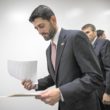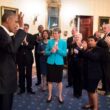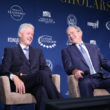Reading through the text of President Bush’s State of the Union speech the morning after, it occurred to us that to get real information about the state of our union the last source one should look to is this annual address. The State of the Union has become a dis-infomercial, an overstuffed grab bag of empty promises, focus-group phrases and presidential pomposity.
When it came to the president’s economic policy, his speech certainly struck some familiar notes: more tax cuts, more jobs, cut the budget deficit in half by 2009. But more is going on behind the presidential doublespeak, and so we asked economic guru Doug Henwood to elucidate Bushonomics and what it has wrought. Henwood edits the Left Business Observer and hosts a weekly radio show on economics for New York’s Pacifica Radio affiliate WBAI. His latest book is After the New Economy, from the New Press.
In his address, Bush said that “Americans should not fear our economic future, because we intend to shape it.” As Henwood suggests, that’s precisely what we should fear. Bush and his ilk are shaping our economic future, and not for the better.
George W. Bush is our first president with an MBA, and it shows. He’s delivered an economy that’s been a CEO’s dream: profits are way up, and taxes, at least on CEOs, are way down. Sadly, though, employment and average incomes haven’t done nearly as well. Of course that’s not what Bush would have you believe. In the White House version of things, growth is strong, jobs are being generated, everything is operating with a full head of steam. But by most conventional measures, especially job growth, the Bush years have been the worst of any president in the last fifty years.
In sharp contrast with his predecessor, Bill Clinton, Bush hasn’t paid much attention to economic policy—he’d much rather mount an invasion or tap our phone calls. The quality of his economic appointments has been dismal, and not just for their politics. One of the exceptions, the conservative but intelligent economic adviser Lawrence Lindsey, was fired early on for suggesting that the war in Iraq could cost as much as $200 billion. As it turns out, his estimate was too low, but it was not on message for 2002. Bush’s Treasury Secretaries, Paul O’Neill and now John Snow, have been barely visible, and seem way out of their depth. In the weeks after Bush’s re-election, anonymous administration officials suggested in the papers that Snow would be sacked come January 2005; but it’s said that they couldn’t find a plausible replacement, so he was kept on. According to press reports, serious people rejected job offers for one opening or another because they didn’t want to be used as mere salespeople for policies that would be chosen by Bush’s inner circle.
It’s only a slight exaggeration to say that Bush economic policy has consisted of cutting taxes on the rich and giving natural resource companies free rein to despoil the environment. Much of it feels like a re-run of the Reagan years. Then, as now, easing the burden on business and the rich was supposed to unleash a wave of innovation and investment, and ultimately millions of new jobs and higher incomes were to have been the outcome for all of us. It hasn’t worked out that way.
AXING TAXES—Both the administration and its critics would agree that the centerpiece of Bush’s economic policies have been a series of large cuts in the personal income tax, which have greatly shrunk federal revenues. From time to time, Republican apologists will deny that the tax cuts had anything to do with the growth of the federal deficit, but that’s nonsense.
The Congressional Budget Office (CBO), hardly a partisan Democratic redoubt, computes so-called “standardized” measures of federal revenues and outlays. These are designed to separate out short-term effects and various technical issues and focus on longer-term changes in tax and spending policy. According to the CBO’s estimates, standardized federal revenues fell from 19.3 percent of the gross domestic product (GDP) in 2000 to a low of 16.1 percent in 2003; they’ve since recovered a bit, to a projected 17.0 percent in 2005. Since U.S. GDP (the total value of goods and services produced within our national borders) is around $13 trillion, that shift of 2.3 percentage points means that Washington is taking in almost $300 billion a year less than it would have had the tax cuts not happened.
Yet despite a great deal of rhetoric to the contrary, the Bush years have not seen compensating cuts in federal spending: it has risen by over 1 percent of GDP. This fact drives hardcore conservatives crazy. About three-quarters of the increase can be accounted for by a buildup of the military. Bush and the Republican-controlled Congress have hardly discovered the virtues of public spending on education or the environment; as this article was going to press, Congress had just passed $40 billion in spending cuts, concentrated on Medicare and Medicaid. But putting the tax cuts and spending increases together, you see a huge shift in the federal budget balance, from a surplus of 1.1 percent of GDP in 2000 to a deficit of 2.1 percent last year. That’s not as big as the Reagan deficits of the early 1980s, for sure, but it’s still a boatload of money on a troubling course.
This isn’t to argue that deficits are always bad, or that the large surpluses of the Clinton years were necessarily a good thing. A deficit can be a good way to kick-start a sagging economy. But when the deficits become chronic and structural, as they are now, more and more of the federal budget is devoted to interest payments on the debt, and the right is handed a convenient argument against any new public spending. In fact, you’d almost suspect that this was the point of creating $400 billion deficits in the first place—to have a ready-made argument to cut social spending.
And, as everyone not in the pay of Karl Rove can tell you, the tax cuts were heavily skewed toward the rich. Not merely the upper middle class, even, but the very rich. According to estimates by Citizens for Tax Justice, households with incomes of around $75,000 got an average tax cut of $400 from the GOP’s 2003 scheme; those with $50,000 incomes have saved less than $200 a year; those with $30,000 incomes got almost nothing. But those in the top 1 percent, with incomes around $1 million, got almost $25,000 a year in cuts. About a third of American households live on $25,000 a year or less; millionaires got that much in tax cuts alone. No wonder the rich were such enthusiastic Bush voters in 2004!
THE JAPAN PARADIGM—Regardless of the fairness or prudence of giving millionaires huge tax cuts, one could argue that the deficits that the cuts created were decent as economic policy—a stimulus to counteract the twin shocks of the bursting of the dot-com bubble and, a little over a year later, the 9/11 attacks. And you wouldn’t be entirely wrong to argue that. When Japan’s stock market bubble burst in 1989, it ushered in more than a decade of economic stagnation, to which the Japanese government was very slow to respond. Of course, the administration and its congressional allies didn’t intend the tax cuts as an inoculation against the Japanese experience; they just wanted to give their base some nice fat refund checks.
But intended or not, the deficit did, at least on paper, look like a vast fiscal stimulus, to use the jargon of economics. At the same time, the Federal Reserve, very conscious of trying to avoid what happened to the Japanese, drove short-term interest rates down to 1 percent, a level not seen since the 1950s. In other words, the twin engines of government policy, fiscal and monetary, were both set to full throttle.
Despite all that stimulus, however, the recovery from the 2001 recession has been weak on the surface, and rather bizarre when you look at it more closely. That weak response, despite the massive stimuli coming out of Washington, suggests that there’s an underlying sickness to the economy that just isn’t being addressed.
JOBS DON’T COME BACK—For students of the “business cycle”—the broad upswings and downswings that all capitalist economies are subject to—this expansion has been a strange one indeed. In a phrase, capital has thrived and labor hasn’t. Since the recession ended at the end of 2001, corporate profits are up 81 percent, while the wages that corporations pay their employees are up just 18 percent, a ratio of over four to one. That’s the most lopsided performance of the ten expansions that have occurred since the end of World War II. And that measure of wages is pulled misleadingly higher by the outsized performance of the upper brackets; the pay going to ordinary workers (the 80 percent of the workforce classified by the Bureau of Labor Statistics as “nonsupervisory”) is up only about 14 percent.
The job market of the Bush years is the worst in modern times. Yes, the economy added two million jobs in 2005, but that’s nearly a million short of what we would have seen had historical averages prevailed. Employment continued to fall for a year and a half after the recession’s official end. There’s only one post-World War II precedent for that—the early 1990s, when the job market lagged that abstraction known as “the economy” by eleven months. But even after employment bottomed out, it grew at far slower than the accustomed pace. Putting the long decline and sluggish recovery together, we’re some ten million jobs below where we should be, based on historical averages.
A DEBTOR SOCIETY—Despite tepid income growth, Americans have continued to buy stuff with great enthusiasm. In fact, if you look just at the consumption side of the economy, there was barely a recession in 2001. How’d they manage this? With heroic levels of borrowing.
During the second half of 2005, the savings rate went negative. In other words, in the aggregate, Americans spent more than they earned. Sure, lots of households do that every year, but this was the first time since 1933 that it happened for American households as a whole. It makes sense that, during the Depression, people would try to maintain consumption as incomes collapsed. But in 2006, with our economy nowhere near being in a depression, it’s a pretty strange thing. Economists don’t know for sure, but it probably means that the upper-income households, who used to do almost all the saving (lending part of those savings, through the magic of the financial markets, to those below them in the income distribution) are themselves now also borrowing.
From the late 1940s through the early 1990s Americans saved an average of 8 percent of their after-tax income. That rate started eroding in 1992, and now we’re saving less than nothing. (Economists call this: “dissaving,” which means either drawing down on savings, or borrowing.) In the past, much of this borrowing was with credit cards. Since about 2000, though, the real action has been in home equity credit.
Refinancing old high-interest mortgages with new low-interest ones has been the rage for the last few years, but it’s little appreciated exactly what that means. Typically, people tack on additional principal to their mortgages when they refinance, and they take that increase in cash. Estimates of what are often called cashout refis are huge. Goldman Sachs concludes that some $2 trillion was extracted in the first five years of the new millennium. David Rosenberg of Merrill Lynch considers that about 40 percent of the growth in consumption over the last three years has come from this source.
 And where does the money come from, if the upper classes aren’t saving enough to fund the needs of their servants? Foreign investors, mainly Asian central banks, notably those of China and Japan. The Asian economies are rolling in greenbacks because we import so much more from them than we export to them, so they take that surplus of dollars and buy U.S. Treasury bonds and other securities with them. When you import more than you export, you’re essentially living beyond your means, having to borrow the difference, which is exactly what the U.S. is doing. Or as former Clinton economic adviser Laura Tyson memorably put it: Asia lends, America spends.
And where does the money come from, if the upper classes aren’t saving enough to fund the needs of their servants? Foreign investors, mainly Asian central banks, notably those of China and Japan. The Asian economies are rolling in greenbacks because we import so much more from them than we export to them, so they take that surplus of dollars and buy U.S. Treasury bonds and other securities with them. When you import more than you export, you’re essentially living beyond your means, having to borrow the difference, which is exactly what the U.S. is doing. Or as former Clinton economic adviser Laura Tyson memorably put it: Asia lends, America spends.
The result is the graph you see above: a massive increase in U.S. foreign debt. At the end of the third quarter of 2005, Americans owed the outside world $4.3 trillion more than the outside world owed Americans. Even by the standards of the U.S. economy, that’s a lot of money.
AN UNSUSTAINABLE PROMISE—So this is the Bush economy: huge tax cuts for the rich, stunning increases in corporate profits, belt-tightening for the poor, stagnant wages for most workers, and massive borrowing to keep the whole thing afloat. If the U.S. were an ordinary country, Washington would be dispatching the International Monetary Fund (IMF) to impose an austerity program. But the U.S. is not ordinary, and no one is about to engineer a deep recession, which is what the IMF would prescribe (as it did in Mexico in 1995 and Thailand in 1997).
None of this looks sustainable. With job and wage growth weak, consumer spending has been maintained through reckless levels of borrowing against house prices that have been rising at an unprecedented rate. And with domestic savings now nonexistent, that borrowing has been funded by $2 billion to $3 billion in fresh borrowing from abroad every business day. It looks like something is going to break: Either there will be some sort of financial crisis that will interrupt the gusher of foreign money, throwing the economy into reverse, or some gentler version of that crisis will evolve, spread over the course of years.
Remarkably, almost no one seems seriously concerned about this. Certainly not the president, who laced his State of the Union address with implausible pledges to reduce oil consumption and increase R&D spending (almost literally at the same moment the Energy Department is going to begin layoffs at its National Renewable Energy Laboratory, thanks to budget cuts). This is a very odd state of affairs for a Republican Party that likes to talk about security and prudence. But as we know from its foreign policy, facing reality is not the party’s strong suit. And someday Bush will return to Crawford (or more likely Houston, when scenes of frequent brush-clearing won’t be needed to reinforce his manly image), and the rest of us will have to face the consequences.






0 Comments